Analyzing Challenges Faced by Australian Banking Business Globally
VerifiedAdded on 2023/06/12
|16
|3848
|195
Report
AI Summary
This report examines the challenges confronting the Australian banking sector within the dynamic global business environment. It begins by outlining the evolving nature of the global economy, highlighting increased competition, technological advancements, and shifting customer preferences. The report then focuses on the Australian banking industry, detailing its structure, nature, and specific issues. It explores how global trends impact Australian banks, including the growth of emerging markets, the rapid pace of innovation, and the increasing importance of e-commerce. Furthermore, the report addresses challenges such as political and social instability, cultural differences, supply chain complexities, and stricter government regulations. Ultimately, it aims to provide insights into the obstacles faced by Australian banks and potential strategies to navigate the contemporary global business landscape. Desklib offers this report and many other resources to aid students in their studies.
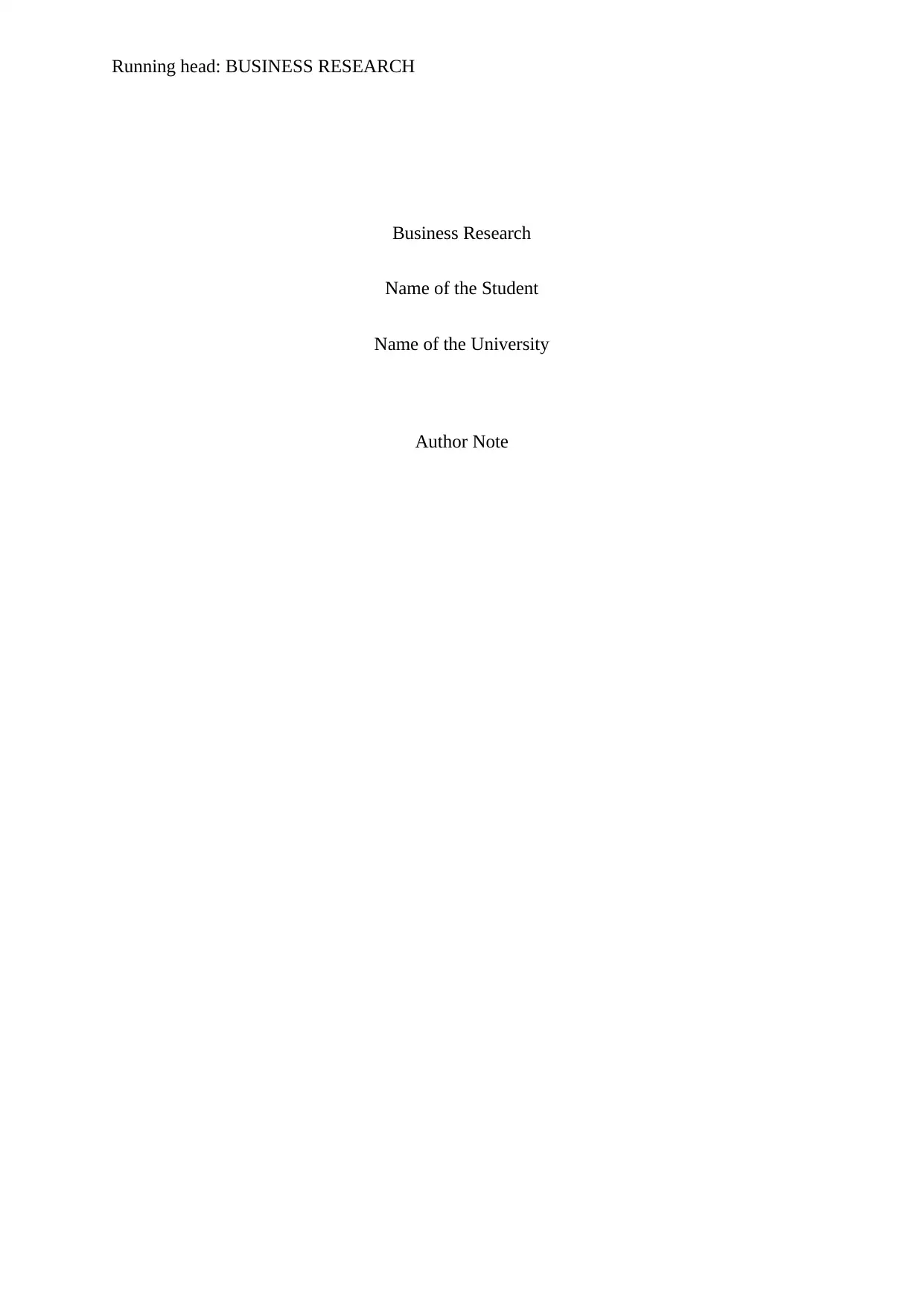
Running head: BUSINESS RESEARCH
Business Research
Name of the Student
Name of the University
Author Note
Business Research
Name of the Student
Name of the University
Author Note
Paraphrase This Document
Need a fresh take? Get an instant paraphrase of this document with our AI Paraphraser
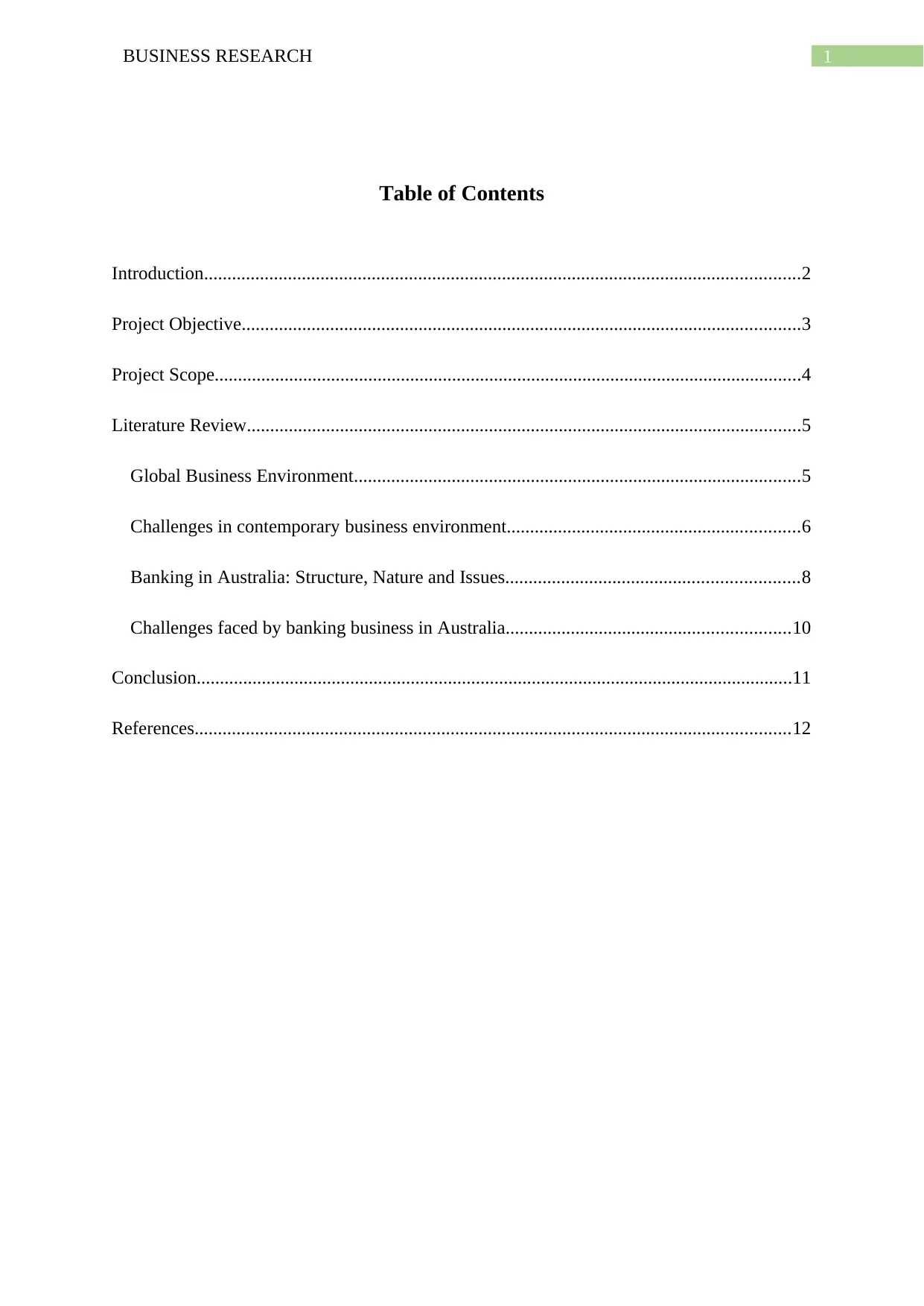
1BUSINESS RESEARCH
Table of Contents
Introduction................................................................................................................................2
Project Objective........................................................................................................................3
Project Scope..............................................................................................................................4
Literature Review.......................................................................................................................5
Global Business Environment................................................................................................5
Challenges in contemporary business environment...............................................................6
Banking in Australia: Structure, Nature and Issues...............................................................8
Challenges faced by banking business in Australia.............................................................10
Conclusion................................................................................................................................11
References................................................................................................................................12
Table of Contents
Introduction................................................................................................................................2
Project Objective........................................................................................................................3
Project Scope..............................................................................................................................4
Literature Review.......................................................................................................................5
Global Business Environment................................................................................................5
Challenges in contemporary business environment...............................................................6
Banking in Australia: Structure, Nature and Issues...............................................................8
Challenges faced by banking business in Australia.............................................................10
Conclusion................................................................................................................................11
References................................................................................................................................12
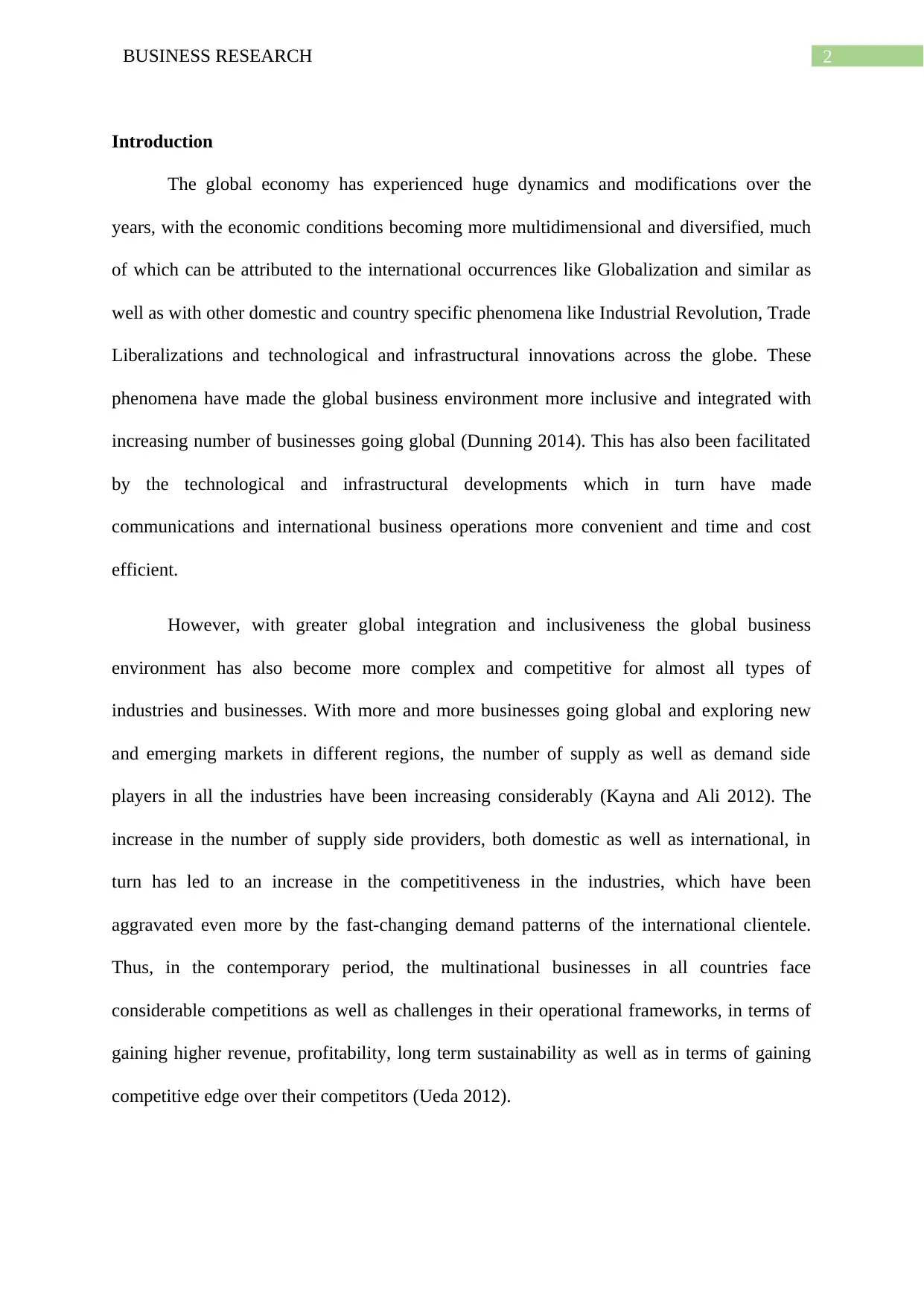
2BUSINESS RESEARCH
Introduction
The global economy has experienced huge dynamics and modifications over the
years, with the economic conditions becoming more multidimensional and diversified, much
of which can be attributed to the international occurrences like Globalization and similar as
well as with other domestic and country specific phenomena like Industrial Revolution, Trade
Liberalizations and technological and infrastructural innovations across the globe. These
phenomena have made the global business environment more inclusive and integrated with
increasing number of businesses going global (Dunning 2014). This has also been facilitated
by the technological and infrastructural developments which in turn have made
communications and international business operations more convenient and time and cost
efficient.
However, with greater global integration and inclusiveness the global business
environment has also become more complex and competitive for almost all types of
industries and businesses. With more and more businesses going global and exploring new
and emerging markets in different regions, the number of supply as well as demand side
players in all the industries have been increasing considerably (Kayna and Ali 2012). The
increase in the number of supply side providers, both domestic as well as international, in
turn has led to an increase in the competitiveness in the industries, which have been
aggravated even more by the fast-changing demand patterns of the international clientele.
Thus, in the contemporary period, the multinational businesses in all countries face
considerable competitions as well as challenges in their operational frameworks, in terms of
gaining higher revenue, profitability, long term sustainability as well as in terms of gaining
competitive edge over their competitors (Ueda 2012).
Introduction
The global economy has experienced huge dynamics and modifications over the
years, with the economic conditions becoming more multidimensional and diversified, much
of which can be attributed to the international occurrences like Globalization and similar as
well as with other domestic and country specific phenomena like Industrial Revolution, Trade
Liberalizations and technological and infrastructural innovations across the globe. These
phenomena have made the global business environment more inclusive and integrated with
increasing number of businesses going global (Dunning 2014). This has also been facilitated
by the technological and infrastructural developments which in turn have made
communications and international business operations more convenient and time and cost
efficient.
However, with greater global integration and inclusiveness the global business
environment has also become more complex and competitive for almost all types of
industries and businesses. With more and more businesses going global and exploring new
and emerging markets in different regions, the number of supply as well as demand side
players in all the industries have been increasing considerably (Kayna and Ali 2012). The
increase in the number of supply side providers, both domestic as well as international, in
turn has led to an increase in the competitiveness in the industries, which have been
aggravated even more by the fast-changing demand patterns of the international clientele.
Thus, in the contemporary period, the multinational businesses in all countries face
considerable competitions as well as challenges in their operational frameworks, in terms of
gaining higher revenue, profitability, long term sustainability as well as in terms of gaining
competitive edge over their competitors (Ueda 2012).
⊘ This is a preview!⊘
Do you want full access?
Subscribe today to unlock all pages.

Trusted by 1+ million students worldwide
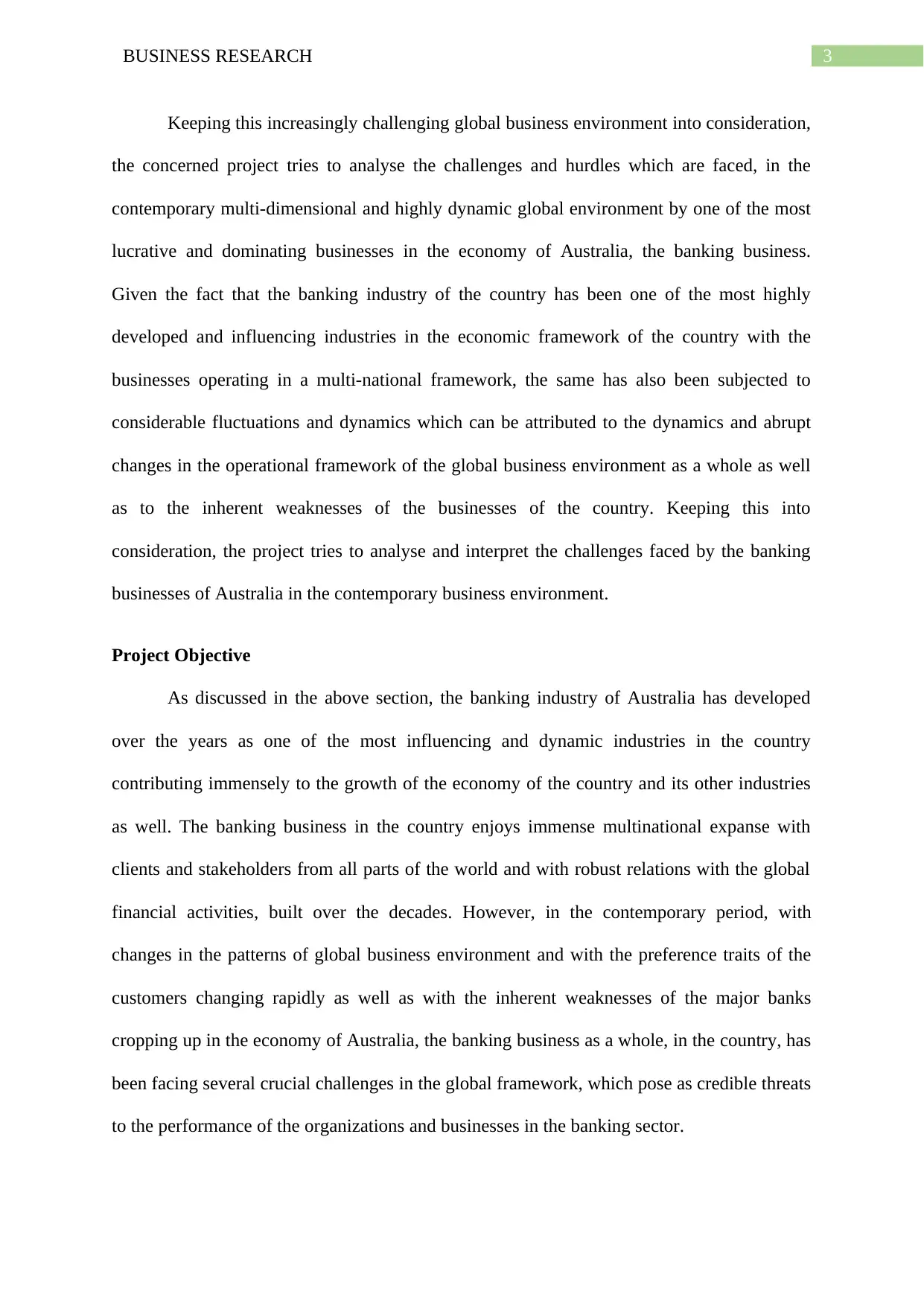
3BUSINESS RESEARCH
Keeping this increasingly challenging global business environment into consideration,
the concerned project tries to analyse the challenges and hurdles which are faced, in the
contemporary multi-dimensional and highly dynamic global environment by one of the most
lucrative and dominating businesses in the economy of Australia, the banking business.
Given the fact that the banking industry of the country has been one of the most highly
developed and influencing industries in the economic framework of the country with the
businesses operating in a multi-national framework, the same has also been subjected to
considerable fluctuations and dynamics which can be attributed to the dynamics and abrupt
changes in the operational framework of the global business environment as a whole as well
as to the inherent weaknesses of the businesses of the country. Keeping this into
consideration, the project tries to analyse and interpret the challenges faced by the banking
businesses of Australia in the contemporary business environment.
Project Objective
As discussed in the above section, the banking industry of Australia has developed
over the years as one of the most influencing and dynamic industries in the country
contributing immensely to the growth of the economy of the country and its other industries
as well. The banking business in the country enjoys immense multinational expanse with
clients and stakeholders from all parts of the world and with robust relations with the global
financial activities, built over the decades. However, in the contemporary period, with
changes in the patterns of global business environment and with the preference traits of the
customers changing rapidly as well as with the inherent weaknesses of the major banks
cropping up in the economy of Australia, the banking business as a whole, in the country, has
been facing several crucial challenges in the global framework, which pose as credible threats
to the performance of the organizations and businesses in the banking sector.
Keeping this increasingly challenging global business environment into consideration,
the concerned project tries to analyse the challenges and hurdles which are faced, in the
contemporary multi-dimensional and highly dynamic global environment by one of the most
lucrative and dominating businesses in the economy of Australia, the banking business.
Given the fact that the banking industry of the country has been one of the most highly
developed and influencing industries in the economic framework of the country with the
businesses operating in a multi-national framework, the same has also been subjected to
considerable fluctuations and dynamics which can be attributed to the dynamics and abrupt
changes in the operational framework of the global business environment as a whole as well
as to the inherent weaknesses of the businesses of the country. Keeping this into
consideration, the project tries to analyse and interpret the challenges faced by the banking
businesses of Australia in the contemporary business environment.
Project Objective
As discussed in the above section, the banking industry of Australia has developed
over the years as one of the most influencing and dynamic industries in the country
contributing immensely to the growth of the economy of the country and its other industries
as well. The banking business in the country enjoys immense multinational expanse with
clients and stakeholders from all parts of the world and with robust relations with the global
financial activities, built over the decades. However, in the contemporary period, with
changes in the patterns of global business environment and with the preference traits of the
customers changing rapidly as well as with the inherent weaknesses of the major banks
cropping up in the economy of Australia, the banking business as a whole, in the country, has
been facing several crucial challenges in the global framework, which pose as credible threats
to the performance of the organizations and businesses in the banking sector.
Paraphrase This Document
Need a fresh take? Get an instant paraphrase of this document with our AI Paraphraser
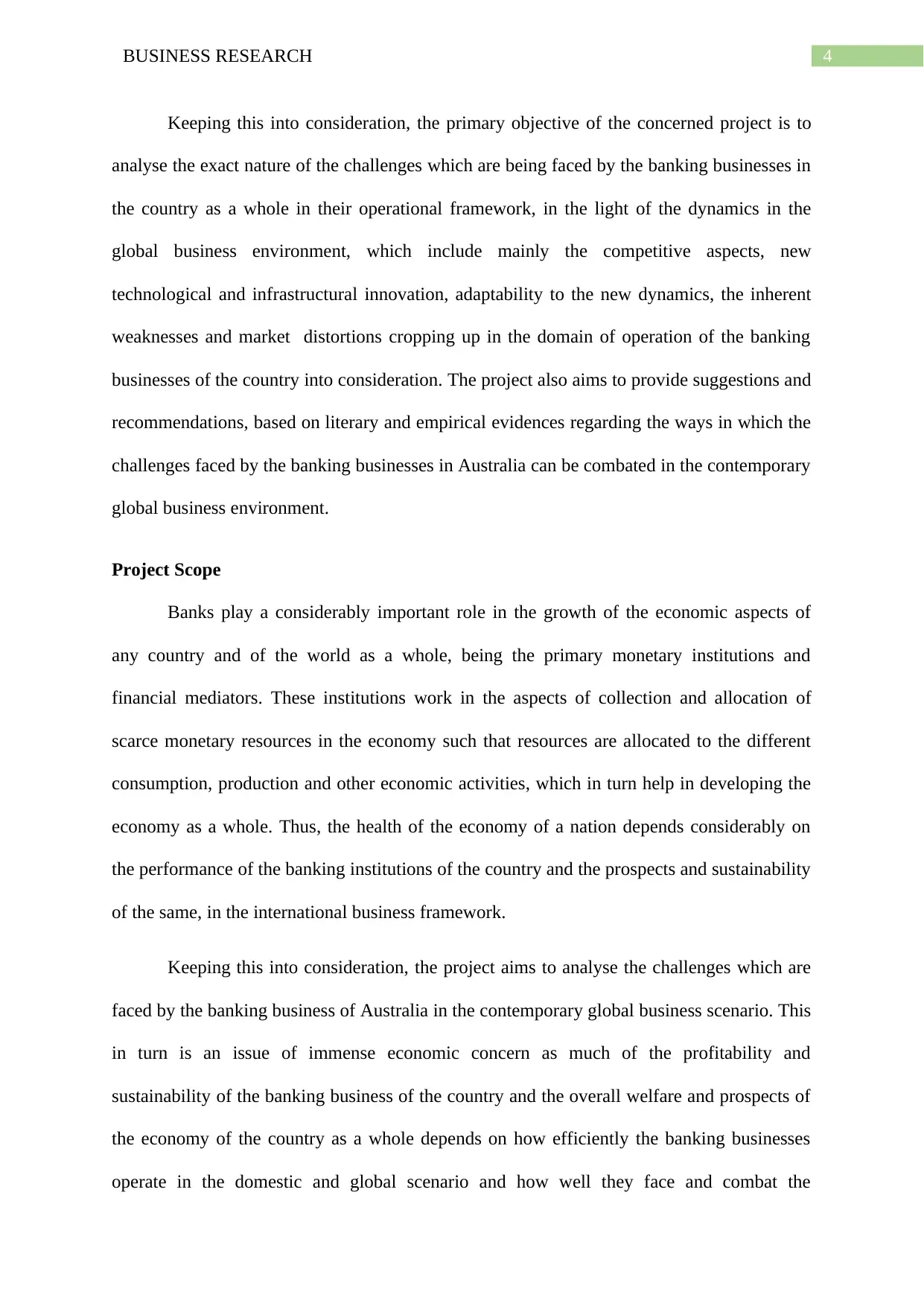
4BUSINESS RESEARCH
Keeping this into consideration, the primary objective of the concerned project is to
analyse the exact nature of the challenges which are being faced by the banking businesses in
the country as a whole in their operational framework, in the light of the dynamics in the
global business environment, which include mainly the competitive aspects, new
technological and infrastructural innovation, adaptability to the new dynamics, the inherent
weaknesses and market distortions cropping up in the domain of operation of the banking
businesses of the country into consideration. The project also aims to provide suggestions and
recommendations, based on literary and empirical evidences regarding the ways in which the
challenges faced by the banking businesses in Australia can be combated in the contemporary
global business environment.
Project Scope
Banks play a considerably important role in the growth of the economic aspects of
any country and of the world as a whole, being the primary monetary institutions and
financial mediators. These institutions work in the aspects of collection and allocation of
scarce monetary resources in the economy such that resources are allocated to the different
consumption, production and other economic activities, which in turn help in developing the
economy as a whole. Thus, the health of the economy of a nation depends considerably on
the performance of the banking institutions of the country and the prospects and sustainability
of the same, in the international business framework.
Keeping this into consideration, the project aims to analyse the challenges which are
faced by the banking business of Australia in the contemporary global business scenario. This
in turn is an issue of immense economic concern as much of the profitability and
sustainability of the banking business of the country and the overall welfare and prospects of
the economy of the country as a whole depends on how efficiently the banking businesses
operate in the domestic and global scenario and how well they face and combat the
Keeping this into consideration, the primary objective of the concerned project is to
analyse the exact nature of the challenges which are being faced by the banking businesses in
the country as a whole in their operational framework, in the light of the dynamics in the
global business environment, which include mainly the competitive aspects, new
technological and infrastructural innovation, adaptability to the new dynamics, the inherent
weaknesses and market distortions cropping up in the domain of operation of the banking
businesses of the country into consideration. The project also aims to provide suggestions and
recommendations, based on literary and empirical evidences regarding the ways in which the
challenges faced by the banking businesses in Australia can be combated in the contemporary
global business environment.
Project Scope
Banks play a considerably important role in the growth of the economic aspects of
any country and of the world as a whole, being the primary monetary institutions and
financial mediators. These institutions work in the aspects of collection and allocation of
scarce monetary resources in the economy such that resources are allocated to the different
consumption, production and other economic activities, which in turn help in developing the
economy as a whole. Thus, the health of the economy of a nation depends considerably on
the performance of the banking institutions of the country and the prospects and sustainability
of the same, in the international business framework.
Keeping this into consideration, the project aims to analyse the challenges which are
faced by the banking business of Australia in the contemporary global business scenario. This
in turn is an issue of immense economic concern as much of the profitability and
sustainability of the banking business of the country and the overall welfare and prospects of
the economy of the country as a whole depends on how efficiently the banking businesses
operate in the domestic and global scenario and how well they face and combat the
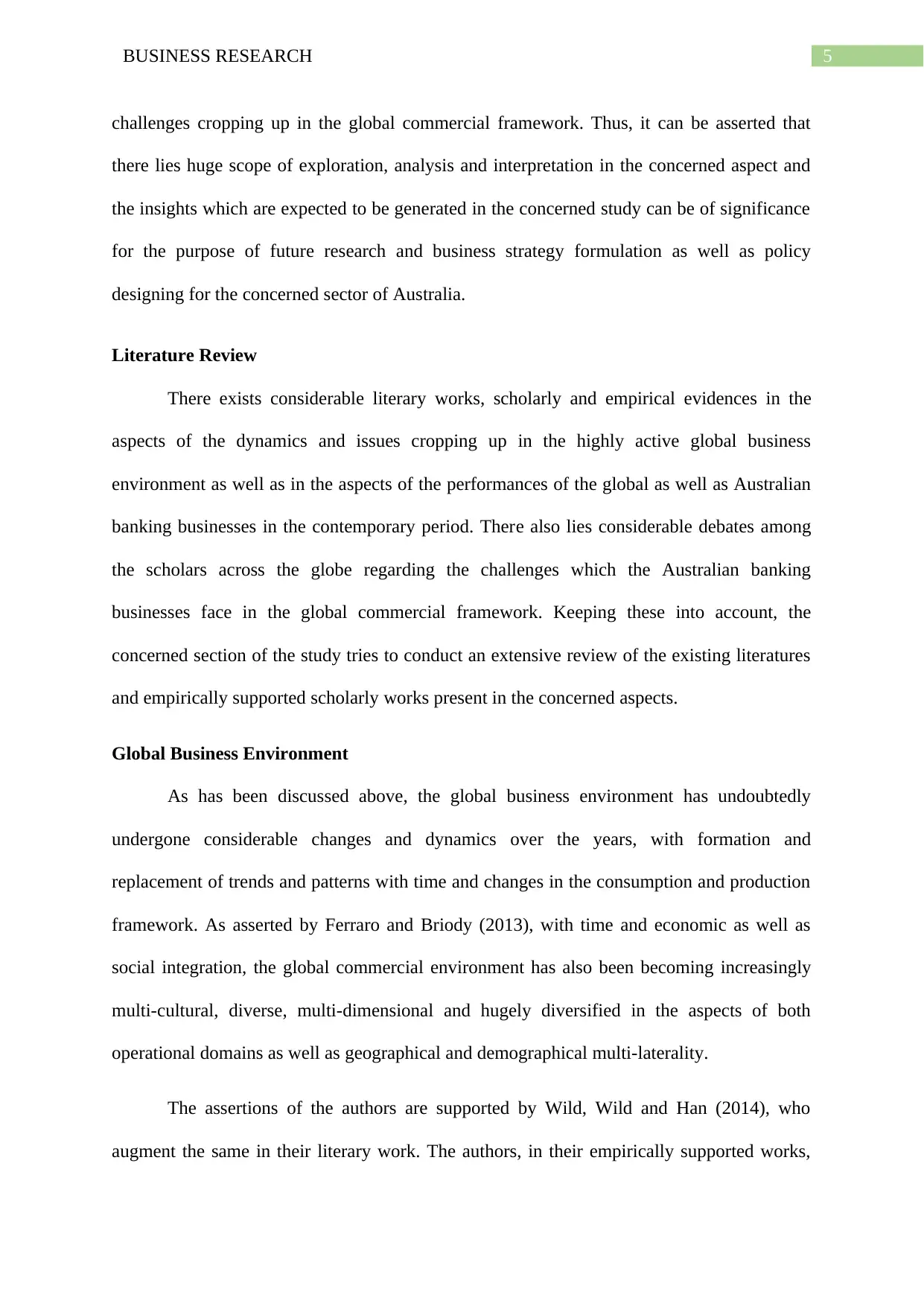
5BUSINESS RESEARCH
challenges cropping up in the global commercial framework. Thus, it can be asserted that
there lies huge scope of exploration, analysis and interpretation in the concerned aspect and
the insights which are expected to be generated in the concerned study can be of significance
for the purpose of future research and business strategy formulation as well as policy
designing for the concerned sector of Australia.
Literature Review
There exists considerable literary works, scholarly and empirical evidences in the
aspects of the dynamics and issues cropping up in the highly active global business
environment as well as in the aspects of the performances of the global as well as Australian
banking businesses in the contemporary period. There also lies considerable debates among
the scholars across the globe regarding the challenges which the Australian banking
businesses face in the global commercial framework. Keeping these into account, the
concerned section of the study tries to conduct an extensive review of the existing literatures
and empirically supported scholarly works present in the concerned aspects.
Global Business Environment
As has been discussed above, the global business environment has undoubtedly
undergone considerable changes and dynamics over the years, with formation and
replacement of trends and patterns with time and changes in the consumption and production
framework. As asserted by Ferraro and Briody (2013), with time and economic as well as
social integration, the global commercial environment has also been becoming increasingly
multi-cultural, diverse, multi-dimensional and hugely diversified in the aspects of both
operational domains as well as geographical and demographical multi-laterality.
The assertions of the authors are supported by Wild, Wild and Han (2014), who
augment the same in their literary work. The authors, in their empirically supported works,
challenges cropping up in the global commercial framework. Thus, it can be asserted that
there lies huge scope of exploration, analysis and interpretation in the concerned aspect and
the insights which are expected to be generated in the concerned study can be of significance
for the purpose of future research and business strategy formulation as well as policy
designing for the concerned sector of Australia.
Literature Review
There exists considerable literary works, scholarly and empirical evidences in the
aspects of the dynamics and issues cropping up in the highly active global business
environment as well as in the aspects of the performances of the global as well as Australian
banking businesses in the contemporary period. There also lies considerable debates among
the scholars across the globe regarding the challenges which the Australian banking
businesses face in the global commercial framework. Keeping these into account, the
concerned section of the study tries to conduct an extensive review of the existing literatures
and empirically supported scholarly works present in the concerned aspects.
Global Business Environment
As has been discussed above, the global business environment has undoubtedly
undergone considerable changes and dynamics over the years, with formation and
replacement of trends and patterns with time and changes in the consumption and production
framework. As asserted by Ferraro and Briody (2013), with time and economic as well as
social integration, the global commercial environment has also been becoming increasingly
multi-cultural, diverse, multi-dimensional and hugely diversified in the aspects of both
operational domains as well as geographical and demographical multi-laterality.
The assertions of the authors are supported by Wild, Wild and Han (2014), who
augment the same in their literary work. The authors, in their empirically supported works,
⊘ This is a preview!⊘
Do you want full access?
Subscribe today to unlock all pages.

Trusted by 1+ million students worldwide
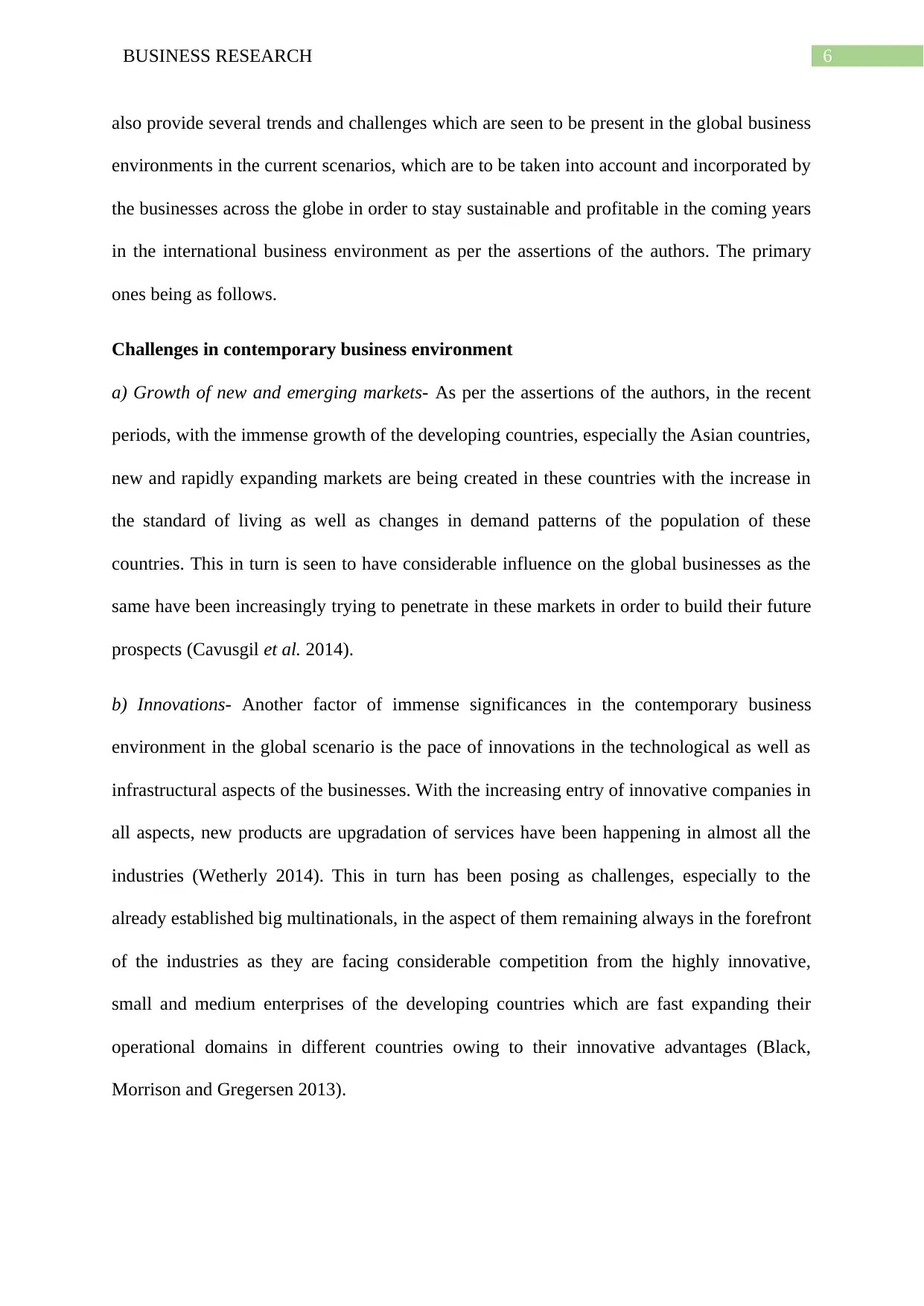
6BUSINESS RESEARCH
also provide several trends and challenges which are seen to be present in the global business
environments in the current scenarios, which are to be taken into account and incorporated by
the businesses across the globe in order to stay sustainable and profitable in the coming years
in the international business environment as per the assertions of the authors. The primary
ones being as follows.
Challenges in contemporary business environment
a) Growth of new and emerging markets- As per the assertions of the authors, in the recent
periods, with the immense growth of the developing countries, especially the Asian countries,
new and rapidly expanding markets are being created in these countries with the increase in
the standard of living as well as changes in demand patterns of the population of these
countries. This in turn is seen to have considerable influence on the global businesses as the
same have been increasingly trying to penetrate in these markets in order to build their future
prospects (Cavusgil et al. 2014).
b) Innovations- Another factor of immense significances in the contemporary business
environment in the global scenario is the pace of innovations in the technological as well as
infrastructural aspects of the businesses. With the increasing entry of innovative companies in
all aspects, new products are upgradation of services have been happening in almost all the
industries (Wetherly 2014). This in turn has been posing as challenges, especially to the
already established big multinationals, in the aspect of them remaining always in the forefront
of the industries as they are facing considerable competition from the highly innovative,
small and medium enterprises of the developing countries which are fast expanding their
operational domains in different countries owing to their innovative advantages (Black,
Morrison and Gregersen 2013).
also provide several trends and challenges which are seen to be present in the global business
environments in the current scenarios, which are to be taken into account and incorporated by
the businesses across the globe in order to stay sustainable and profitable in the coming years
in the international business environment as per the assertions of the authors. The primary
ones being as follows.
Challenges in contemporary business environment
a) Growth of new and emerging markets- As per the assertions of the authors, in the recent
periods, with the immense growth of the developing countries, especially the Asian countries,
new and rapidly expanding markets are being created in these countries with the increase in
the standard of living as well as changes in demand patterns of the population of these
countries. This in turn is seen to have considerable influence on the global businesses as the
same have been increasingly trying to penetrate in these markets in order to build their future
prospects (Cavusgil et al. 2014).
b) Innovations- Another factor of immense significances in the contemporary business
environment in the global scenario is the pace of innovations in the technological as well as
infrastructural aspects of the businesses. With the increasing entry of innovative companies in
all aspects, new products are upgradation of services have been happening in almost all the
industries (Wetherly 2014). This in turn has been posing as challenges, especially to the
already established big multinationals, in the aspect of them remaining always in the forefront
of the industries as they are facing considerable competition from the highly innovative,
small and medium enterprises of the developing countries which are fast expanding their
operational domains in different countries owing to their innovative advantages (Black,
Morrison and Gregersen 2013).
Paraphrase This Document
Need a fresh take? Get an instant paraphrase of this document with our AI Paraphraser
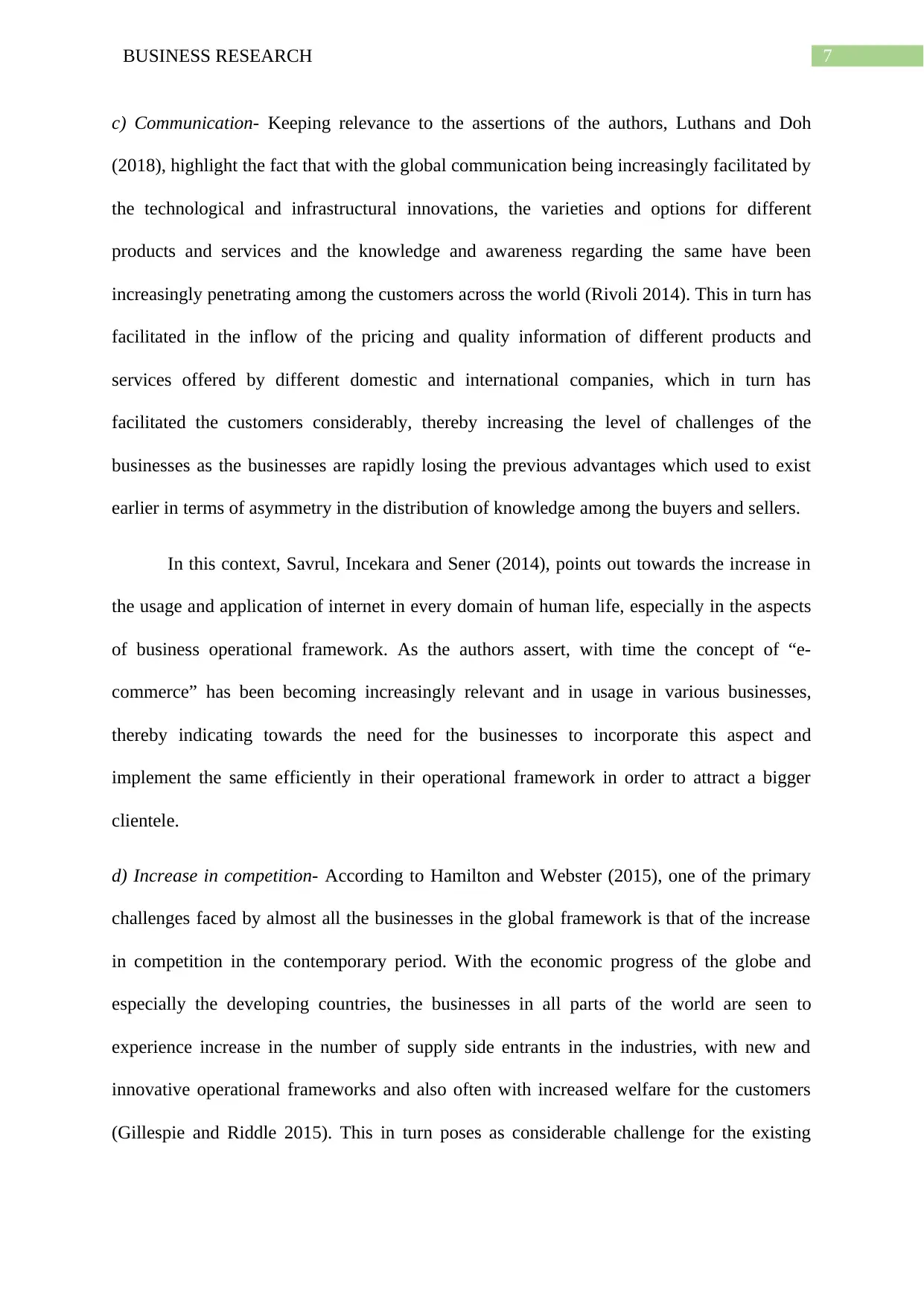
7BUSINESS RESEARCH
c) Communication- Keeping relevance to the assertions of the authors, Luthans and Doh
(2018), highlight the fact that with the global communication being increasingly facilitated by
the technological and infrastructural innovations, the varieties and options for different
products and services and the knowledge and awareness regarding the same have been
increasingly penetrating among the customers across the world (Rivoli 2014). This in turn has
facilitated in the inflow of the pricing and quality information of different products and
services offered by different domestic and international companies, which in turn has
facilitated the customers considerably, thereby increasing the level of challenges of the
businesses as the businesses are rapidly losing the previous advantages which used to exist
earlier in terms of asymmetry in the distribution of knowledge among the buyers and sellers.
In this context, Savrul, Incekara and Sener (2014), points out towards the increase in
the usage and application of internet in every domain of human life, especially in the aspects
of business operational framework. As the authors assert, with time the concept of “e-
commerce” has been becoming increasingly relevant and in usage in various businesses,
thereby indicating towards the need for the businesses to incorporate this aspect and
implement the same efficiently in their operational framework in order to attract a bigger
clientele.
d) Increase in competition- According to Hamilton and Webster (2015), one of the primary
challenges faced by almost all the businesses in the global framework is that of the increase
in competition in the contemporary period. With the economic progress of the globe and
especially the developing countries, the businesses in all parts of the world are seen to
experience increase in the number of supply side entrants in the industries, with new and
innovative operational frameworks and also often with increased welfare for the customers
(Gillespie and Riddle 2015). This in turn poses as considerable challenge for the existing
c) Communication- Keeping relevance to the assertions of the authors, Luthans and Doh
(2018), highlight the fact that with the global communication being increasingly facilitated by
the technological and infrastructural innovations, the varieties and options for different
products and services and the knowledge and awareness regarding the same have been
increasingly penetrating among the customers across the world (Rivoli 2014). This in turn has
facilitated in the inflow of the pricing and quality information of different products and
services offered by different domestic and international companies, which in turn has
facilitated the customers considerably, thereby increasing the level of challenges of the
businesses as the businesses are rapidly losing the previous advantages which used to exist
earlier in terms of asymmetry in the distribution of knowledge among the buyers and sellers.
In this context, Savrul, Incekara and Sener (2014), points out towards the increase in
the usage and application of internet in every domain of human life, especially in the aspects
of business operational framework. As the authors assert, with time the concept of “e-
commerce” has been becoming increasingly relevant and in usage in various businesses,
thereby indicating towards the need for the businesses to incorporate this aspect and
implement the same efficiently in their operational framework in order to attract a bigger
clientele.
d) Increase in competition- According to Hamilton and Webster (2015), one of the primary
challenges faced by almost all the businesses in the global framework is that of the increase
in competition in the contemporary period. With the economic progress of the globe and
especially the developing countries, the businesses in all parts of the world are seen to
experience increase in the number of supply side entrants in the industries, with new and
innovative operational frameworks and also often with increased welfare for the customers
(Gillespie and Riddle 2015). This in turn poses as considerable challenge for the existing
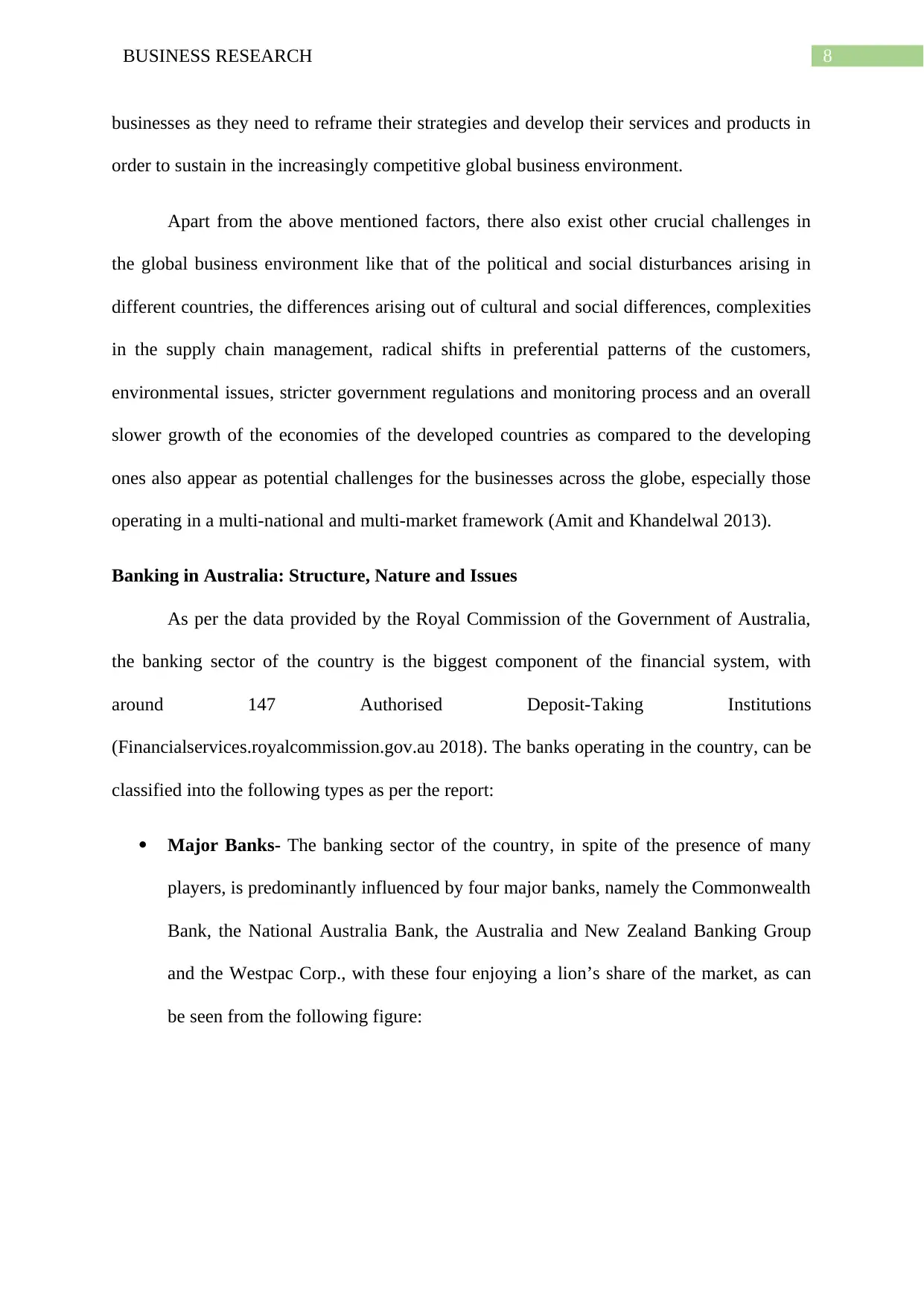
8BUSINESS RESEARCH
businesses as they need to reframe their strategies and develop their services and products in
order to sustain in the increasingly competitive global business environment.
Apart from the above mentioned factors, there also exist other crucial challenges in
the global business environment like that of the political and social disturbances arising in
different countries, the differences arising out of cultural and social differences, complexities
in the supply chain management, radical shifts in preferential patterns of the customers,
environmental issues, stricter government regulations and monitoring process and an overall
slower growth of the economies of the developed countries as compared to the developing
ones also appear as potential challenges for the businesses across the globe, especially those
operating in a multi-national and multi-market framework (Amit and Khandelwal 2013).
Banking in Australia: Structure, Nature and Issues
As per the data provided by the Royal Commission of the Government of Australia,
the banking sector of the country is the biggest component of the financial system, with
around 147 Authorised Deposit-Taking Institutions
(Financialservices.royalcommission.gov.au 2018). The banks operating in the country, can be
classified into the following types as per the report:
Major Banks- The banking sector of the country, in spite of the presence of many
players, is predominantly influenced by four major banks, namely the Commonwealth
Bank, the National Australia Bank, the Australia and New Zealand Banking Group
and the Westpac Corp., with these four enjoying a lion’s share of the market, as can
be seen from the following figure:
businesses as they need to reframe their strategies and develop their services and products in
order to sustain in the increasingly competitive global business environment.
Apart from the above mentioned factors, there also exist other crucial challenges in
the global business environment like that of the political and social disturbances arising in
different countries, the differences arising out of cultural and social differences, complexities
in the supply chain management, radical shifts in preferential patterns of the customers,
environmental issues, stricter government regulations and monitoring process and an overall
slower growth of the economies of the developed countries as compared to the developing
ones also appear as potential challenges for the businesses across the globe, especially those
operating in a multi-national and multi-market framework (Amit and Khandelwal 2013).
Banking in Australia: Structure, Nature and Issues
As per the data provided by the Royal Commission of the Government of Australia,
the banking sector of the country is the biggest component of the financial system, with
around 147 Authorised Deposit-Taking Institutions
(Financialservices.royalcommission.gov.au 2018). The banks operating in the country, can be
classified into the following types as per the report:
Major Banks- The banking sector of the country, in spite of the presence of many
players, is predominantly influenced by four major banks, namely the Commonwealth
Bank, the National Australia Bank, the Australia and New Zealand Banking Group
and the Westpac Corp., with these four enjoying a lion’s share of the market, as can
be seen from the following figure:
⊘ This is a preview!⊘
Do you want full access?
Subscribe today to unlock all pages.

Trusted by 1+ million students worldwide
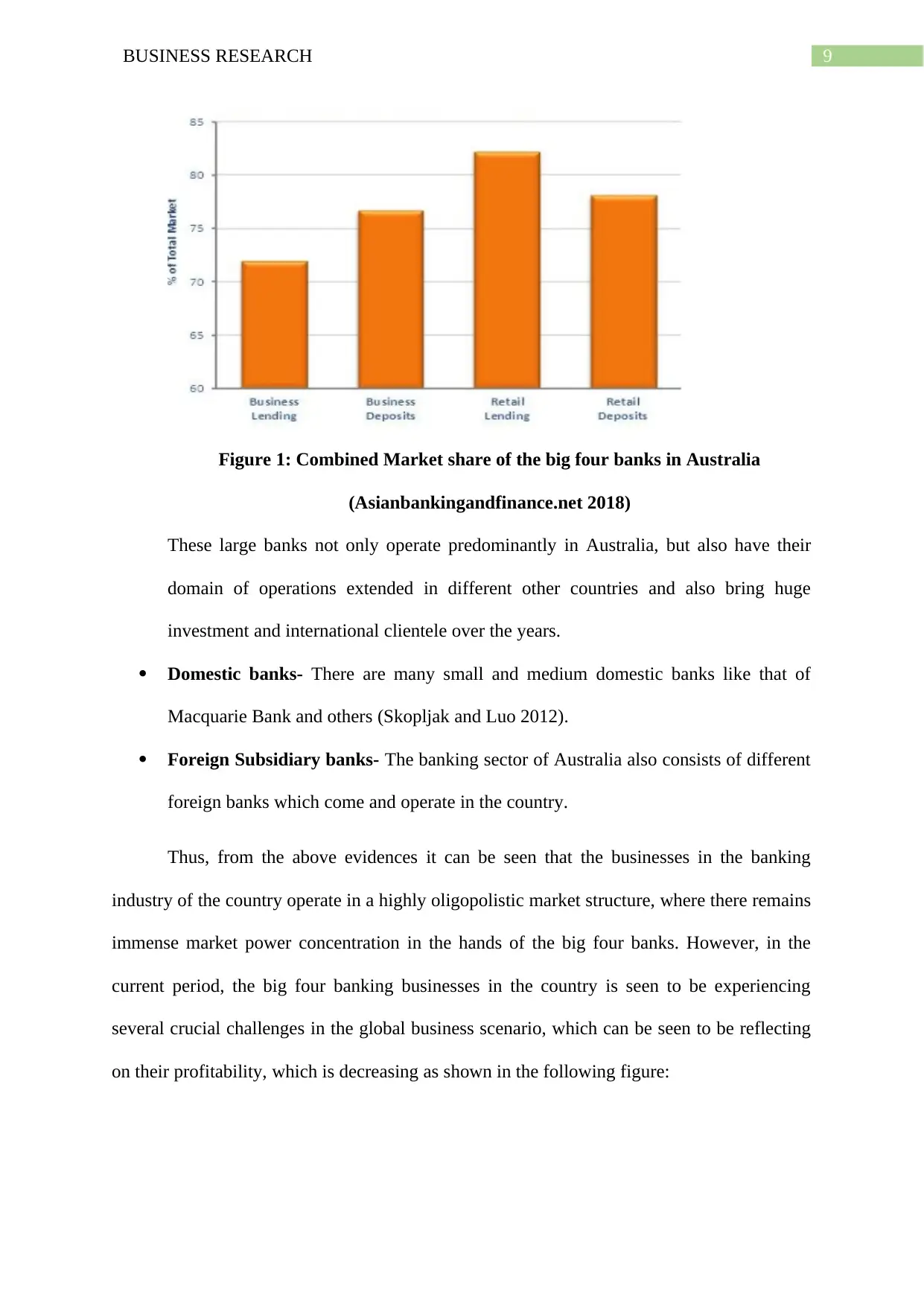
9BUSINESS RESEARCH
Figure 1: Combined Market share of the big four banks in Australia
(Asianbankingandfinance.net 2018)
These large banks not only operate predominantly in Australia, but also have their
domain of operations extended in different other countries and also bring huge
investment and international clientele over the years.
Domestic banks- There are many small and medium domestic banks like that of
Macquarie Bank and others (Skopljak and Luo 2012).
Foreign Subsidiary banks- The banking sector of Australia also consists of different
foreign banks which come and operate in the country.
Thus, from the above evidences it can be seen that the businesses in the banking
industry of the country operate in a highly oligopolistic market structure, where there remains
immense market power concentration in the hands of the big four banks. However, in the
current period, the big four banking businesses in the country is seen to be experiencing
several crucial challenges in the global business scenario, which can be seen to be reflecting
on their profitability, which is decreasing as shown in the following figure:
Figure 1: Combined Market share of the big four banks in Australia
(Asianbankingandfinance.net 2018)
These large banks not only operate predominantly in Australia, but also have their
domain of operations extended in different other countries and also bring huge
investment and international clientele over the years.
Domestic banks- There are many small and medium domestic banks like that of
Macquarie Bank and others (Skopljak and Luo 2012).
Foreign Subsidiary banks- The banking sector of Australia also consists of different
foreign banks which come and operate in the country.
Thus, from the above evidences it can be seen that the businesses in the banking
industry of the country operate in a highly oligopolistic market structure, where there remains
immense market power concentration in the hands of the big four banks. However, in the
current period, the big four banking businesses in the country is seen to be experiencing
several crucial challenges in the global business scenario, which can be seen to be reflecting
on their profitability, which is decreasing as shown in the following figure:
Paraphrase This Document
Need a fresh take? Get an instant paraphrase of this document with our AI Paraphraser
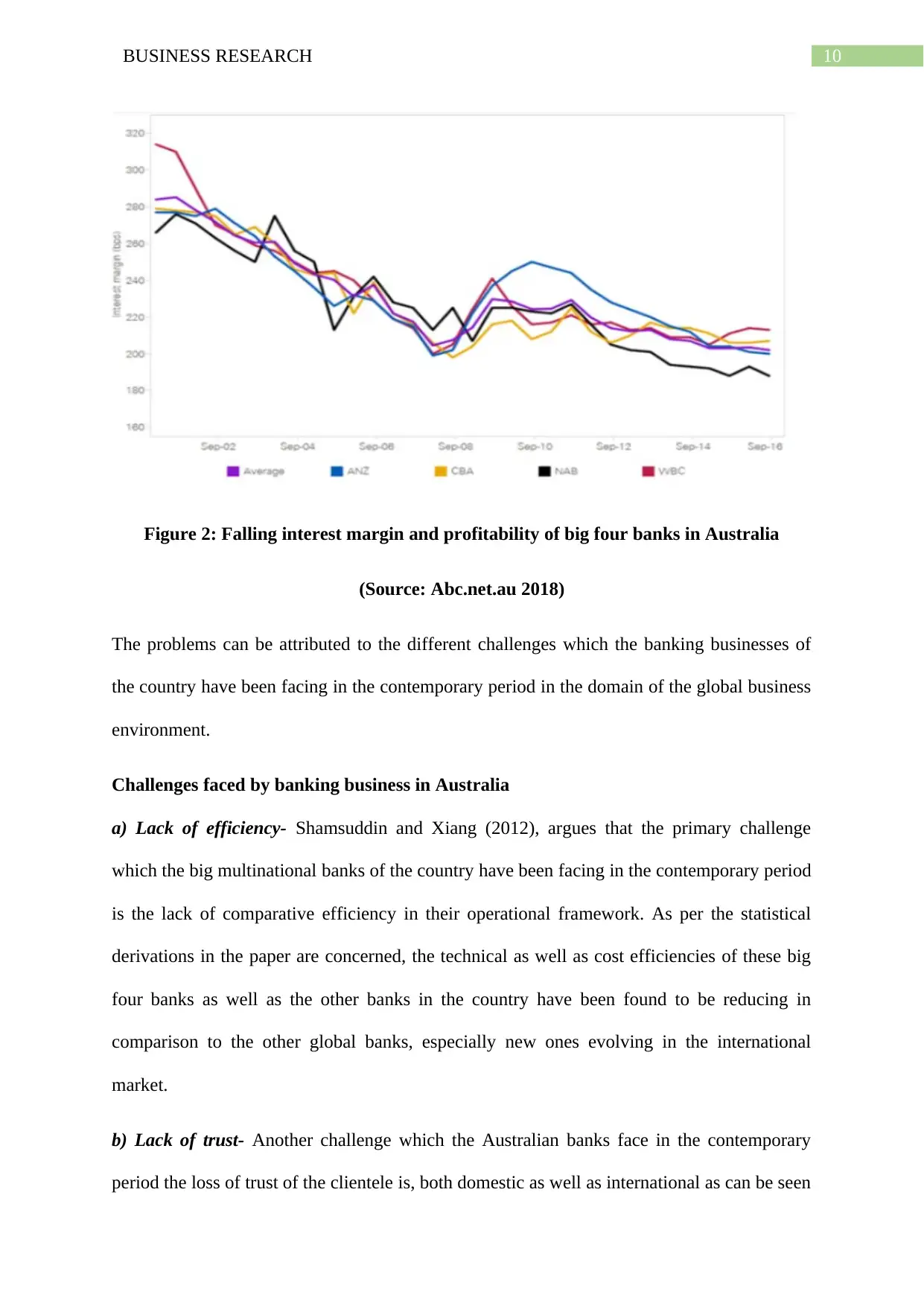
10BUSINESS RESEARCH
Figure 2: Falling interest margin and profitability of big four banks in Australia
(Source: Abc.net.au 2018)
The problems can be attributed to the different challenges which the banking businesses of
the country have been facing in the contemporary period in the domain of the global business
environment.
Challenges faced by banking business in Australia
a) Lack of efficiency- Shamsuddin and Xiang (2012), argues that the primary challenge
which the big multinational banks of the country have been facing in the contemporary period
is the lack of comparative efficiency in their operational framework. As per the statistical
derivations in the paper are concerned, the technical as well as cost efficiencies of these big
four banks as well as the other banks in the country have been found to be reducing in
comparison to the other global banks, especially new ones evolving in the international
market.
b) Lack of trust- Another challenge which the Australian banks face in the contemporary
period the loss of trust of the clientele is, both domestic as well as international as can be seen
Figure 2: Falling interest margin and profitability of big four banks in Australia
(Source: Abc.net.au 2018)
The problems can be attributed to the different challenges which the banking businesses of
the country have been facing in the contemporary period in the domain of the global business
environment.
Challenges faced by banking business in Australia
a) Lack of efficiency- Shamsuddin and Xiang (2012), argues that the primary challenge
which the big multinational banks of the country have been facing in the contemporary period
is the lack of comparative efficiency in their operational framework. As per the statistical
derivations in the paper are concerned, the technical as well as cost efficiencies of these big
four banks as well as the other banks in the country have been found to be reducing in
comparison to the other global banks, especially new ones evolving in the international
market.
b) Lack of trust- Another challenge which the Australian banks face in the contemporary
period the loss of trust of the clientele is, both domestic as well as international as can be seen
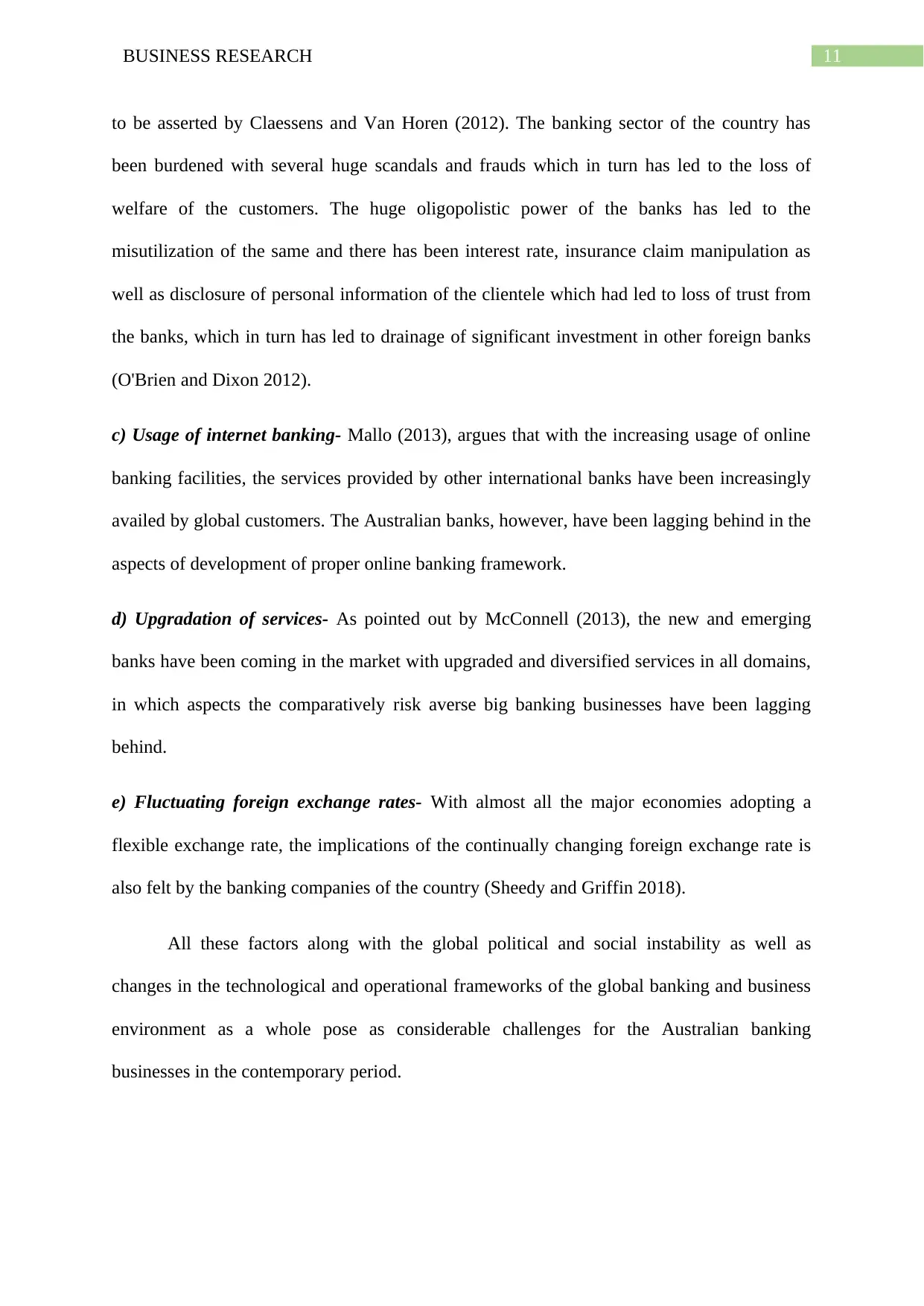
11BUSINESS RESEARCH
to be asserted by Claessens and Van Horen (2012). The banking sector of the country has
been burdened with several huge scandals and frauds which in turn has led to the loss of
welfare of the customers. The huge oligopolistic power of the banks has led to the
misutilization of the same and there has been interest rate, insurance claim manipulation as
well as disclosure of personal information of the clientele which had led to loss of trust from
the banks, which in turn has led to drainage of significant investment in other foreign banks
(O'Brien and Dixon 2012).
c) Usage of internet banking- Mallo (2013), argues that with the increasing usage of online
banking facilities, the services provided by other international banks have been increasingly
availed by global customers. The Australian banks, however, have been lagging behind in the
aspects of development of proper online banking framework.
d) Upgradation of services- As pointed out by McConnell (2013), the new and emerging
banks have been coming in the market with upgraded and diversified services in all domains,
in which aspects the comparatively risk averse big banking businesses have been lagging
behind.
e) Fluctuating foreign exchange rates- With almost all the major economies adopting a
flexible exchange rate, the implications of the continually changing foreign exchange rate is
also felt by the banking companies of the country (Sheedy and Griffin 2018).
All these factors along with the global political and social instability as well as
changes in the technological and operational frameworks of the global banking and business
environment as a whole pose as considerable challenges for the Australian banking
businesses in the contemporary period.
to be asserted by Claessens and Van Horen (2012). The banking sector of the country has
been burdened with several huge scandals and frauds which in turn has led to the loss of
welfare of the customers. The huge oligopolistic power of the banks has led to the
misutilization of the same and there has been interest rate, insurance claim manipulation as
well as disclosure of personal information of the clientele which had led to loss of trust from
the banks, which in turn has led to drainage of significant investment in other foreign banks
(O'Brien and Dixon 2012).
c) Usage of internet banking- Mallo (2013), argues that with the increasing usage of online
banking facilities, the services provided by other international banks have been increasingly
availed by global customers. The Australian banks, however, have been lagging behind in the
aspects of development of proper online banking framework.
d) Upgradation of services- As pointed out by McConnell (2013), the new and emerging
banks have been coming in the market with upgraded and diversified services in all domains,
in which aspects the comparatively risk averse big banking businesses have been lagging
behind.
e) Fluctuating foreign exchange rates- With almost all the major economies adopting a
flexible exchange rate, the implications of the continually changing foreign exchange rate is
also felt by the banking companies of the country (Sheedy and Griffin 2018).
All these factors along with the global political and social instability as well as
changes in the technological and operational frameworks of the global banking and business
environment as a whole pose as considerable challenges for the Australian banking
businesses in the contemporary period.
⊘ This is a preview!⊘
Do you want full access?
Subscribe today to unlock all pages.

Trusted by 1+ million students worldwide
1 out of 16
Related Documents
Your All-in-One AI-Powered Toolkit for Academic Success.
+13062052269
info@desklib.com
Available 24*7 on WhatsApp / Email
![[object Object]](/_next/static/media/star-bottom.7253800d.svg)
Unlock your academic potential
Copyright © 2020–2025 A2Z Services. All Rights Reserved. Developed and managed by ZUCOL.





